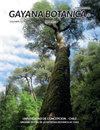Taxonomic identity of Camelina armeniaca, a forgotten early name in Camelina (Brassicaceae)
IF 0.5
4区 生物学
Q4 PLANT SCIENCES
引用次数: 0
Abstract
The long-forgotten and taxonomically problematic name Camelina armeniaca Desv. is one of the earliest speciesʼ names published in Camelina (Brassicaceae; Cruciferae). Because of that, the issue of its proper taxonomic application was important for the nomenclatural stability of taxa belonging to the C. sativa–C. microcarpa aggregate and containing the important oilseed and biofuel crop C. sativa and its wild relatives and progenitors. The name Camelina armeniaca is lectotypified here with the specimen P00652666 from the Tournefort Herbarium (Herbarium Tournefortianum No. 1634) in P, following the direct reference in the protologue. Judging from the morphological characters of the lectotype, taxonomically, it represents a morphotype of C. sativa sensu lato, probably most closely matching C. caucasica (C. sativa var. caucasica) from a morphological viewpoint. Contrary to the recent listing of C. armeniaca in synonymy (!) of C. microcarpa in several main biodiversity databases (such as GBIF, POWO, etc.), we conclude that C. armeniaca is definitely not conspecific with C. microcarpa. Because of that, nomenclatural conservation of the latter name against the earlier one is unnecessary, as well as a possible proposal to reject the name C. armeniaca. We prefer to treat C. armeniaca as a taxonomic synonym of C. sativa. A corrected typification (lectotypification and epitypification) of the name C. sativa var. caucasica is also provided.茶树属(芸苔科)中一个被遗忘的早期名称——亚美尼亚茶树的分类鉴定
被遗忘已久且在分类学上有问题的名字Camelina armeniaca Desv。是油菜科(Camelina)中最早公布的种名之一;十字花科)。因此,其正确的分类学应用问题对苜蓿属植物分类群的命名稳定性具有重要意义。含有重要的油料和生物燃料作物芥花及其野生近缘种和祖先。在图尔纳福特植物标本馆(Herbarium Tournefortianum No. 1634)的标本P00652666中,根据原始目录中的直接引用,这里对Camelina armeniaca的名称进行了lectotypate。从其形态特征来看,在分类学上,它代表了一种感觉型的形态型,从形态上看,它可能最接近于白种人(C. sativa var. caucasica)。与最近几个主要生物多样性数据库(如GBIF、POWO等)将青姜属(C. armeniaca)列为小叶姜属(C. microcarpa)的同义种(!)相反,我们认为青姜属与小叶姜属(C. microcarpa)绝对不是同种。正因为如此,后者的名称与前者的命名守恒是不必要的,以及可能拒绝C. armeniaca名称的建议。我们更倾向于把亚美尼亚C.作为C. sativa的分类学同义词。还提供了名称C. sativa var. caucasica的正确分型(lectotypation和epittypation)。
本文章由计算机程序翻译,如有差异,请以英文原文为准。
求助全文
约1分钟内获得全文
求助全文
来源期刊

GAYANA BOTANICA
Agricultural and Biological Sciences-Plant Science
CiteScore
0.70
自引率
0.00%
发文量
8
审稿时长
6-12 weeks
期刊介绍:
The journal welcomes works carried out by scientists of all nationalities, and may be written in either English or Spanish. The journal receives works in systematic, taxonomy, floristic, ecology, physiology, morphology, development, conservation, cytology and phytochemical botany.
 求助内容:
求助内容: 应助结果提醒方式:
应助结果提醒方式:


